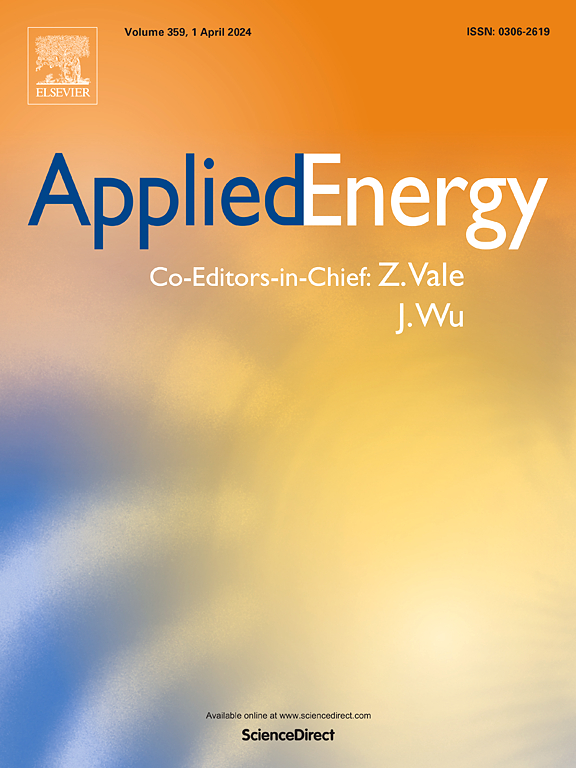Performance assessment and fast diagnosis of a μ-CHP solid oxide fuel cell system
IF 10.1
1区 工程技术
Q1 ENERGY & FUELS
引用次数: 0
Abstract
Online performance characterization and faulty condition diagnosis of micro-combined-heat-and-power (-CHP) solid oxide fuel cell (SOFC) system is crucial for ensuring safe in-house operation and lifespan prolongation. However, fast accurate detection of faulty conditions and performance characterization of compact SOFC system remains a problem. This study applied multiple diagnostic methods to characterize a -CHP SOFC system, including chronopotentiometry, electrochemical impedance spectroscopy (EIS), total harmonic distortion (THD) tool. Performance characterization and condition diagnosis were performed under different power demands, fuel starvation, high-carbon fuel feed and long-term operation. EIS results under normal conditions and fuel starvation showed that the bottom 27-cell half stack, located away from the fuel inlet, received less fuel compared to the top 30-cell half stack. Dispersion analysis indicated the safe fuel utilization for the system should be maintained below 81 % to avoid fuel starvation. THD measurements revealed that fuel starvation could be effectively detected by sinusoidal excitation with frequencies between 0.01 and 0.1 Hz, where a high THD index was observed. The carbon deposition behavior was examined by adjusting the carbon to oxygen ratio (COR) at the catalytic partial oxidation reactor inlet. With COR up to 1, no significant carbon deposition was detected according to the EIS measurements, system voltage and temperature monitoring. During long-term operation under normal conditions, no substantial degradation was detected, demonstrating stable and reliable power and heat generation. The novelty of this work included (1) the identification of operational variability between two half stacks, (2) the rapid detection of fuel starvation conditions using THD analysis, (3) performance assessment under high carbon fuel feed, and (4) long-term degradation characterization.
μ-CHP固体氧化物燃料电池系统性能评估与快速诊断
微热电联产(μ-CHP)固体氧化物燃料电池(SOFC)系统的在线性能表征和故障状态诊断对于确保内部安全运行和延长使用寿命至关重要。然而,快速准确地检测故障状态和表征紧凑SOFC系统的性能仍然是一个问题。本研究采用时序电位法、电化学阻抗谱(EIS)、总谐波失真(THD)等多种诊断方法对μ-CHP SOFC系统进行了表征。在不同功率需求、燃料饥饿、高碳燃料供给和长期运行下进行了性能表征和状态诊断。正常条件下的EIS结果显示,底部27个电池的半堆,远离燃料进口,与顶部30个电池的半堆相比,获得的燃料更少。分散分析表明,系统的安全燃料利用率应保持在81% %以下,以避免燃料短缺。THD测量表明,通过频率在0.01 ~ 0.1 Hz之间的正弦激励可以有效地检测到燃料饥饿,在此范围内观察到较高的THD指数。通过调整催化部分氧化反应器入口的碳氧比(COR),考察了积碳行为。当COR达到1时,根据EIS测量、系统电压和温度监测,没有检测到明显的碳沉积。在正常条件下的长期运行中,没有检测到实质性的退化,证明了稳定可靠的电力和热量产生。这项工作的新颖性包括(1)识别两个半堆之间的操作可变性,(2)使用THD分析快速检测燃料短缺状况,(3)高碳燃料供给下的性能评估,以及(4)长期降解特性。
本文章由计算机程序翻译,如有差异,请以英文原文为准。
求助全文
约1分钟内获得全文
求助全文
来源期刊

Applied Energy
工程技术-工程:化工
CiteScore
21.20
自引率
10.70%
发文量
1830
审稿时长
41 days
期刊介绍:
Applied Energy serves as a platform for sharing innovations, research, development, and demonstrations in energy conversion, conservation, and sustainable energy systems. The journal covers topics such as optimal energy resource use, environmental pollutant mitigation, and energy process analysis. It welcomes original papers, review articles, technical notes, and letters to the editor. Authors are encouraged to submit manuscripts that bridge the gap between research, development, and implementation. The journal addresses a wide spectrum of topics, including fossil and renewable energy technologies, energy economics, and environmental impacts. Applied Energy also explores modeling and forecasting, conservation strategies, and the social and economic implications of energy policies, including climate change mitigation. It is complemented by the open-access journal Advances in Applied Energy.
 求助内容:
求助内容: 应助结果提醒方式:
应助结果提醒方式:


